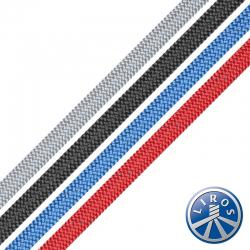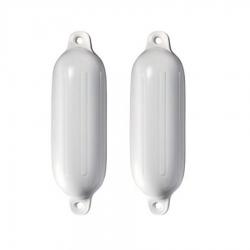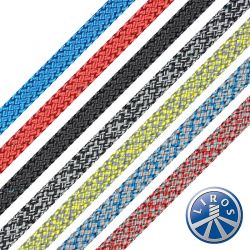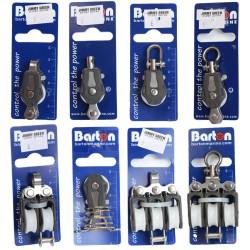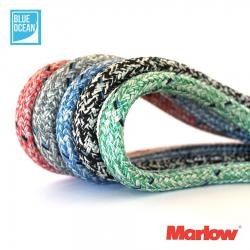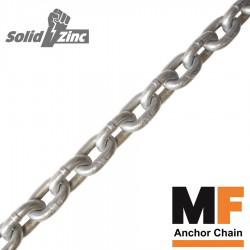Every sailing or motor yacht that ventures from their home berth will be sure to need an anchoring system that they can rely on in adverse weather at some point.
A calibrated anchor chain forms an integral part of the system. An anchor rode can vary between:
- All chain for serious cruising on yachts fitted with a windlass - a short warp at the bitter end and/or a snubbing line will help absorb any shock loading
- A combination of rope spliced to chain offers the best of both components - the proportions can be selected according to individual requirements
- an extended length of warp with a short piece of chain for the anchor end - for kedge warps, doubling up as drogue or towing lines
It stands to reason that the strength and the durability of the chain will be vital for yachts that rely heavily on their anchoring system on an extended cruise, and especially those equipped with all chain and combination rodes with a substantial proportion of chain.
The correct matching calibration is critical to the successful and reliable operation of your windlass - there is more information below, and also in these two articles:
How to identify the correct calibration for your gypsy General information on Calibration and why it is important
Jimmy Green Marine offers a choice of three top-quality manufacturers for Hot Dip Galvanised Grade 40 Calibrated, high-load Grade 70 Calibrated Anchor Chain, as well as a range of Grade 4, Grade 6, and Grade 6+ stainless steel calibrated anchor chain.
Jimmy Green offers Hot Dip Galvanised Grade 40 Calibrated Anchor Chain from three World-Respected Manufacturers:
 Lofrans Grade 40 Calibrated Anchor Chain
Lofrans Grade 40 Calibrated Anchor Chain
Sourced exclusively from Lofrans, renowned worldwide for their range of top quality windlasses.
Lofrans manufacturing is based in Monza, Italy.
Lofrans has been producing top-quality windlasses for over 50 years, more recently accompanied by a chain to match.
Lofrans Grade 40 chain is stamped "LFR" at regular intervals for provenance, serving as testimony to their commitment to the quality of their chain.
 Titan Grade 43 Calibrated Anchor Chain
Titan Grade 43 Calibrated Anchor Chain
Titan™ Marine is a brand of Canada Metal (Pacific) specialising in world-class marine Anchor chains.
Titan Grade 43 Calibrated, hot dip galvanised Anchor Chain is engineered and proof-tested by CMP to specifications exceeding industry standards.
Titan's specification and break loads are a testament to the quality of the steel and the manufacturing process.
All Titan Grade 43 Chain is embossed at regular intervals with G43, CMP and DIN766 or ISO4565 as appropriate as a clear testament to their confidence in the chain and galvanising quality.
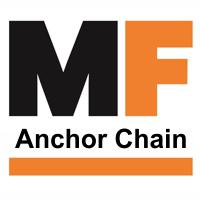
MF Grade 40 Calibrated Anchor Chain featuring EN ISO 461 Regulated, MF Salt-Spray Tested Hot Dip Galvanising
MF Grade 40 Calibrated Anchor Chain features EN ISO 461 Regulated, MF Salt-Spray Tested Hot Dip Galvanising to a micron depth of 80 ± 10 µ. for long-lasting corrosion resistance.
Jimmy Green's MF Chain is sourced exclusively and directly from MF Catenificio Frigerio, a modern chain manufacturing plant in Italy.
MF Catenificio proof tests each link during production at their cutting-edge, research, test and manufacturing facility.
The state-of-the-art MF factory is situated in Olginate, near Lecco, on the shores of Lake Como, Italy.
The proof load testing process ensures that each weld has been completed successfully.


MF DAMS Grade 70 Calibrated Anchor Chain featuring EN ISO 461 Regulated, MF Salt-Spray Tested Hot Dip Galvanising
MF DAMS Grade 70 High-Load Calibrated Anchor Chain features EN ISO 461 Regulated, MF Salt-Spray Tested Hot Dip Galvanising to a micron depth of 80 ± 10 µ. for long-lasting corrosion resistance.
Jimmy Green's MF Grade 70 Chain is sourced exclusively and directly from MF Catenificio Frigerio, a modern chain manufacturing plant in Italy.
MF Catenificio proof tests each link during production to ensure that each weld has been completed successfully.
Galvanising and Provenance
Hot Dip Galvanising is the process of safeguarding the chain from corrosive elements by immersion in molten zinc at a temperature of around 450 °C (842 °F).
The zinc chemically reacts with the steel to form a metallurgically bonded, protective coating that is infused into the steel.
Therefore, it is not just a surface finish that can flake off.
The process of galvanising anchor chain presents some problems due to the number of movable parts (chain links) and the weight involved.
All our chain deliveries are manually checked for any sign of defective galvanising.
Galvanising treatment is measured in microns and typically has a depth of 80-100 microns on good quality anchor chain.
Galvanising - the treatment explained
Provenance is crucial for your peace of mind when it comes to your anchor chain, because although a careful scrutiny of the galvanising will reveal any rust stains or defects, it is nearly impossible to check the steel specification without a metallurgist's report.
Hallmarking will at least confirm the manufacturer.
Certification will state the grade of steel and the rated break load.
Jimmy Green offers Stainless Steel Calibrated Anchor Chain from two World-Renowned Manufacturers.
William Hackett Stainless Steel Calibrated Anchor Chain, manufactured on automatic chain-making machines from A316L to Grade 4
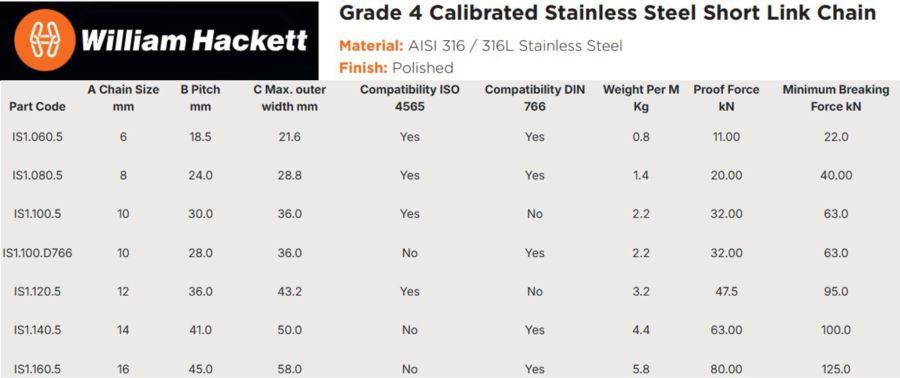
Cromox G6 AISI 316L and G6 PLUS AISI 318LN calibrated stainless steel anchor chain, manufactured in the Ketten Walder factory based near Munich in Germany.

Ketten Walder has been producing the highest quality marine grade 60 chains for 60 years.
The attention to detail, stringent testing and checking processes ensure that every chain meets the highest standards.
Cromox is available in two specifications: G6 AISI 316L and G6 PLUS AISI 318LN.
Bright polished finish is standard.
G6 Plus comes with a manufacturer 2 2-year corrosion-free warranty as standard. The guarantee can be extended to 3 years with an extra electro-polish process, which smooths out micro imperfections and removes ferritic ions to prevent corrosion and staining.
Quality Control and Accountability
Every length of chain is quality checked and labelled with the manufacturer, the date received and a corresponding batch number when it arrives at Jimmy Green Marine.
The batch number is then recorded at the point of sale.
Every chain order is therefore traceable and accountable to the Manufacturer's Test Certificate.
Chain Certificates
A copy of the Manufacturer Test Certificate corresponding precisely to the manufactured length from which your chain has been cut is available with your order on request.
Chain is heavy to manhandle and costly to deliver:
Our Delivery charge is based on the total weight and the delivery destination Zip Code.
Lengths of chain under 50kg will generally be packed in a polypropylene sack (sometimes doubled for security)
Lengths of Chain over 50kg will generally be packed on a pallet.
The Freight cost is calculated in the basket and assumes a UK Mainland delivery address until you are signed in with your registered delivery zip code.
You are welcome to collect from our Chandlery Store to save this cost.
Calibrated Anchor Chain - General Information
Calibrated chain is essential if you have a windlass fitted on your yacht or if you are considering a windlass in the near future.
Calibrated means that each link is manufactured to exact dimensions within a given tolerance.
Windlass gipsys are generally designed and manufactured to be compatible with a specific size and calibration of chain.
When the dimensions are close but do not match, it isn't easy to detect without a practical trial. The problem occurs typically after a short length has been through the gypsy under load. The difference in size between the chain link and the pocket on the gypsy eventually leads to a jam or a jump.
A wealth of information is available on the internet regarding the calibration of windlasses. This information may come from the manufacturer or even from a fellow yachter. This is an excellent guide and could well be accurate. However there are some ‘caveats’ which need to be taken into account e.g. Windlasses are usually offered with a choice of different chain sizes and calibrations Any markings or stamps on the gypsy itself may help in this respect. Windlass manufacturers frequently update their specifications over the years, and the details of these changes are not always readily available without extensive research. If you are not 100% sure of the provenance of your yacht, windlass or gypsy then it is possible that the gypsy has been replaced at some time. The replacement could be a different calibration.
There are only two primary calibrations for chains manufactured in Europe: DIN766 and ISO4565.
The good news is that the dimensions for 6mm, 7mm, 8mm and 12mm are identical.
10mm is more difficult because the dimensions are different for DIN766 and ISO4565
Both 10mm calibrations are very commonly used in Europe.
Be aware that selecting the wrong calibration, particularly in 10mm, on the vast majority of windlasses will result in ‘jamming’ or ‘jumping’ under load.
Please note that US Calibrations are entirely different from European DIN766 or ISO4565.
US Chain Descriptions can be confusing because American chandlers tend to cite Working Load Limits rather than Break Loads, and they don't usually refer to the grade of the chain as we do in Europe.
Be cautious with working loads, as the Break Load will depend entirely on the safety factor used by the manufacturer. The Break Load is self-explanatory, as is the Grade (30, 40, or 70).
The term "HT" is quite commonly used in the USA, but it can be confusingly interpreted to refer to two entirely different things.
HT, meaning High Test, refers to Grade 40 or Grade 43.
HT, meaning High Tensile, refers to a higher grade, commonly Grade 70
For information on how Jimmy Green Marine can help you select the matching chain for your windlass, please go to Calibrated Anchor Chain - Determining the correct calibration
Calibrated Anchor Chain - Information on Load Capacity (strength) and Brittleness (shock absorption)
Calibrated Anchor Chain for yachting and boating is generally manufactured in Grade 30, Grade 40, Grade 43 and Grade 70
Grade 30 is adequate for mooring and anchoring, but Grade 40 is 25 %+ stronger and a minimum requirement for any serious-minded cruising skipper.
The weight does not increase with the grade, which affords weight-saving opportunities for the long lengths required for long-distance cruising.
Typical Break Load Comparisons, e.g. 8mm: Grade 30 = 3200kg ~~~ Grade 40 = 4100kg up to 4400kg according to the manufacturer ~~~ Grade 70 = 70kN = approx. 7100kg 10mm: Grade 30 = 5000kg ~~~ Grade 40 = 6400kg up to 7200kg according to the manufacturer ~~~ Grade 70 = 110KN = approx. 11200kg
There are Three Different Methods of recording Manufacturer Load Limits.
- Working Load Limit - Manufacturers publish a working load limit, which is calculated by dividing their break load by a safety factor. The safety factor sometimes varies between chain manufacturers, but is generally 4:1, i.e., the WLL is a quarter of their tested break load. Safety factors can vary significantly according to the industry. For example, tested galvanised shackles of proven origin will typically have a safety factor of 6:1. The Working Load Limit is an indication of what the manufacturers consider to be regular use. The WLL is declared on the Manufacturer Test Certificate
- Proof Load - Lofrans, MF and Titan Chain are all proof-loaded during the manufacturing process. This is a vital check that each link has been successfully welded as it passes through the machine. The Proof Load is generally twice the Working Load Limit, which equates to half the Tested Break Load. The Proof Load is declared on the Manufacturer Test Certificate.
- Break Load - Manufacturers publish a Break Load for their chain. This is the actual tested load which distorts the chain link beyond its capacity to sustain further load. DIN766 and ISO4565 require a specific level of Break Load for each size, calibration and grade of chain. Manufacturers test their chain to ensure that it exceeds the minimum standard. Manufacturers may then elect to declare their Break Load Limit according to the appropriate standard or additionally declare the Actual Break Load. Manufacturers may do this as a claim to be stronger than the competition, but the DIN766 and ISO4565 standard load limits are quite sufficient. The Break Load is declared on the Manufacturer Test Certificate.
Grade 70 chain is produced from Grade 40 steel through a specially designed heat treatment process, resulting in a break load exceeding the Grade 70 standard. A specially amended and carefully supervised process for the initial hot dip galvanising treatment is also required to ensure that the subsequent strength loss is minimised and the finished product satisfies the appropriate standard. There is no evidence to suggest that re-galvanising has any detrimental effect on the strength of any grade of anchor chain as long as it is carried out professionally, because the heating effect is not cumulative.
Brittleness and Shock Loading
It is not a myth that Grade 30 chain is very slightly more ductile than Grade 40 and Grade 70 chain. This means that it may distort very slightly more just before breaking. However, the relative difference in brittleness should not be a concern. Once you have subjected your anchor chain to anything like the break load limit, the brittleness effect on the capacity of the chain to survive the extreme forces involved will be minimal. This applies to any of the different grades: 30, 40, 43, 70. The higher the grade of the chain, the tougher it is. Tougher means more resilient to higher loads and more resistant to damage from, for example, impact or abrasion. By far the most important aspect of deploying an anchor chain in severe conditions is to avoid shock loading at all costs. Evidently, the higher the grade that you select for your anchor chain, the less likely you are to overload it.
Higher Grade = Higher Break Load = Less chance of Overloading
Shock Absorption, also known as Snubbing for your Anchor Chain
Jimmy Green insights into Anchor Chain Snubbing
The best methods of protecting your chain from having to cope with a snatch load:
- Have as long a main (bower) anchor chain as possible ready to deploy so that even in the worst conditions, there is still enough to cope without the chain straightening at the climax of the surge caused by the combination of wind and waves or even in dire cases, surf. It's the jolt (jerk, snatch, shock) that may cause the chain to fail. N.B. The shock load will also be detrimental to any deck fitting that attaches the chain to the deck.
- Extend your anchor rode with a stretchy Anchorplait Nylon rope to absorb the shock if the chain straightens. Anchorplait can be spliced directly to the chain to ensure a secure and in most cases gypsy friendly connection.
- Deploy an Anchor Chain Snubber - Snubbing helps to smooth out any movement and also protects the chain from jerking if it should straighten.
Main Menu
Main Menu
Back
Main Menu
Back
Main Menu
Back
Back
Main Menu
Back
Main Menu
Back
Back
Main Menu
Back
Main Menu
Main Menu
Back
Main Menu
Back
Back
Back
Back
Back
Back
Back
Back







